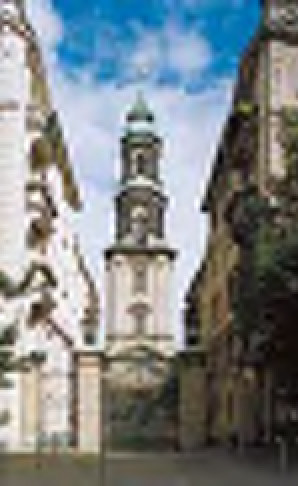Travel Reference
In-Depth Information
Oranienburger Straße
Like no other street, Oranien-
burger Straße, in the centre of
the old Scheunenviertel, symbol-
izes the rise and fall of Jewish
culture in Berlin. Traces of its
Jewish past are visible all along
the street, such as the Neue
Synagoge and several Jewish
cafés and restaurants
(see p129)
.
Some 18th- and 19th-century
buildings bear witness to the
street's former splendour - the
Postfuhramt
(see p125),
for
example, or the house at No.
71-72, built in 1789 by Christian
Friedrich Becherer for the Grand
Lodge of the Freemasons of
Germany.
d
Mitte, between Friedrich-
str. and Rosenthaler Str.
•
Map J4/5
typical of this style: geometric
patterns are laid out in vibrant
colours on glazed tiles, covering
the entire building from the foun-
dations to the guttering. What
had lain in ruin after 1945 has
now been carefully restored,
and forms today one of the most
popular nightlife centres in the
city. Restaurants and cafés
(see
p128-9)
, the Varieté Chamäleon
(see p56)
, galleries and small
shops have all settled in this
area.
d
Rosenthaler Str. 40-41
•
Map I5
Sophienstraße
Narrow Sophienstraße has
been beautifully restored and
now looks exactly as it did in the
late 18th century. A number of
shops and arts and crafts work-
shops are now based in the
modest buildings and courtyards.
Close by stands Sophienkirche,
the first Protestant parish church,
founded by Queen Sophie Luise
in 1712. Next to the Baroque
church is a small cemetery with
some 18th-century tombs.
d
Große Hamburger Str. 29
•
Map I5
Neue Synagoge
The New Synagogue, built
in 1859-66, was once the largest
in Europe. In 1938, it managed
to survive “Reichskristallnacht”
thanks to the vigilance of a brave
guard, but it was damaged by
bombs during World War II.
Behind the Moorish façades are
a prayer room and the Centrum
Judaicum.
d
Oranienburger Str. 29-30
•
Map J4/5
•
10am-6pm Sun-Thu,
10am-2pm Fri
•
(030) 28 40 13 16
•
Free
admission
Hackesche Höfe
Berlin's largest and most
attractive group of restored
commercial buildings, Hackesche
Höfe extends between Oranien-
burger and Rosenthaler Straße
and up to Sophienstraße in the
east. The complex of buildings,
comprised of nine interconnect-
ing courtyards, was designed
around the turn of the 20th
century by Kurt Berndt and
August Endell, two leading
exponents of Art Nouveau.
The first courtyard especially
features elements that are
The old Sophienkirche
123











